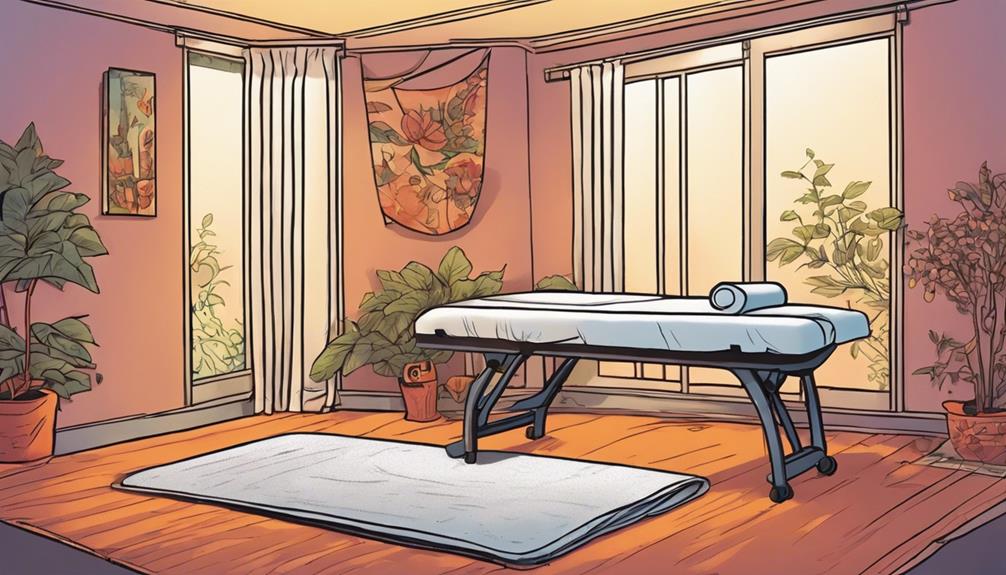Breath-led movement calms chronic pain faster than pills by directly impacting your nervous system, helping you shift from stress to relaxation quickly. Focused breathing releases emotional tension stored in your body, easing pain and reducing anxiety. It also increases awareness of subtle physical and emotional cues, promoting self-healing. Unlike medication, this gentle approach empowers you to manage pain naturally and holistically. Keep exploring how this technique can transform your pain management journey.
Key Takeaways
- Breath-led movement directly influences the nervous system, promoting relaxation and reducing pain without side effects.
- It helps release emotional tension tied to chronic pain, addressing emotional factors pills may not target.
- Focused breathing enhances mind-body awareness, enabling early detection and management of pain signals.
- This holistic approach fosters emotional resilience and self-empowerment, accelerating pain relief naturally.
- Unlike pills, breath-led movement supports long-term emotional and physical healing through consistent practice.

Have you ever considered that your breath might hold the key to managing chronic pain? It’s a simple yet powerful tool that can directly influence your mind-body connection, helping you tap into emotional release and create a profound shift in how you experience pain. When you focus on your breath, you’re not just supplying oxygen—you’re engaging your nervous system and calming your mind. This process can interrupt the pain cycle by grounding you in the present moment, reducing anxiety, and releasing stored emotional tension that often intensifies physical discomfort.
Chronic pain isn’t just physical; it’s deeply intertwined with your emotional state. Sometimes, pain persists because it’s linked to unresolved emotional issues or stress that’s been stored in your body. Breath-led movement acts as a gentle bridge, allowing you to access this emotional release in a controlled, mindful way. As you breathe intentionally, you signal your nervous system to shift from a fight-or-flight response to a relaxation state. This shift doesn’t just relax your muscles—it also helps clear emotional blockages, which can be a root cause or a perpetuator of pain. With each deep, conscious breath, you’re creating space to let go of tension, fear, or frustration that might have been held deep within your body.
Breath transforms emotional pain into relaxation, releasing tension stored deep within your body.
By integrating breath into movement, you’re actively cultivating awareness of your physical sensations and emotional responses. This heightened awareness amplifies your mind-body connection, making you more attuned to subtle shifts in your pain levels and emotional state. When you consciously coordinate movement with breath, you encourage your body to relax and reset. This isn’t about pushing through pain but about gently easing into movements that honor your body’s signals. Over time, this practice can diminish the intensity of pain because it addresses both the physical and emotional layers intertwined in your experience.
Moreover, breath-led movement offers a non-invasive, drug-free approach that you can incorporate anytime, anywhere. It’s accessible and adaptable to your unique needs. As you develop a regular practice, you’ll likely notice a decrease in pain severity and duration, along with an increased sense of calm and emotional clarity. This holistic technique empowers you to regain control, fostering healing from within. Ultimately, harnessing your breath isn’t just about managing pain—it’s about reconnecting with yourself, releasing emotional burdens, and nurturing your body’s innate ability to heal. Practicing mindful breathing can also enhance your overall mental health by reducing stress and promoting emotional resilience, making it a vital component of holistic pain management.
Frequently Asked Questions
Can Breath-Led Movement Replace All Pain Medications?
You wonder if breath-led movement can replace all pain medications. While it’s a promising alternative therapy that helps reduce medication dependence, it may not work for everyone or every type of pain. You should consult your healthcare provider before making changes. Breath-led movement can be a powerful part of your pain management plan, but it’s important to combine it with other treatments for all-encompassing relief.
How Long Does It Typically Take to See Results?
Imagine you start a daily mindfulness practice combined with breath-led movement. Many notice relief within a few weeks, as these relaxation techniques help reduce pain sensitivity. Your body responds quickly, often within 2-4 weeks, but consistent practice is key. While individual results vary, regular engagement in these techniques can accelerate pain relief, making it a faster, natural alternative to medication.
Is Breath-Led Movement Suitable for Severe Chronic Pain?
You might wonder if breath-led movement suits severe chronic pain. It often is, because it enhances your mind body connection and uses gentle breathing techniques to reduce pain. While it can be very effective, it’s important to start slowly and consult with a healthcare professional. Breath-led movement helps manage pain by calming your nervous system and promoting relaxation, making it a valuable complementary approach even for severe cases.
Are There Any Risks or Side Effects Involved?
You might wonder if breath-led movement has risks, especially regarding medication interactions or side effects. Generally, it’s safe and gentle, but if you’re on medication, consult your healthcare provider to avoid any adverse interactions. Side effects are rare, but listen to your body—stop if you feel discomfort. Proper guidance helps manage any concerns, ensuring you benefit from calming breath techniques without unintended effects.
Can This Method Be Combined With Other Therapies?
You can definitely combine breath-led movement with other therapies, as it enhances the mind-body connection and complements integrative approaches. Incorporating techniques like meditation, physical therapy, or chiropractic care can amplify pain relief and overall well-being. Always consult your healthcare provider to make certain these methods work well together and suit your specific needs. This holistic approach can accelerate your path to managing chronic pain more effectively.
Conclusion
By focusing on your breath, you can ease your pain, calm your mind, and restore your balance. Breath-led movement helps you break free from tension, reduce stress, and regain control. It’s simple, it’s natural, and it’s effective. When you breathe deeply, you invite relief, invite relaxation, and invite healing. Embrace your breath, embrace your power, and let movement guide you toward comfort. Your journey to pain relief begins with each mindful breath you take.










